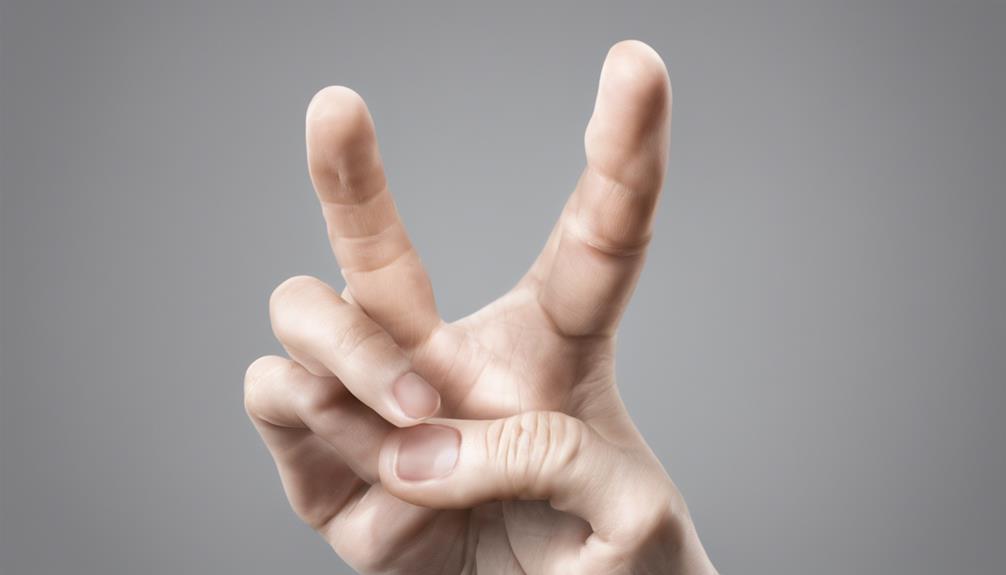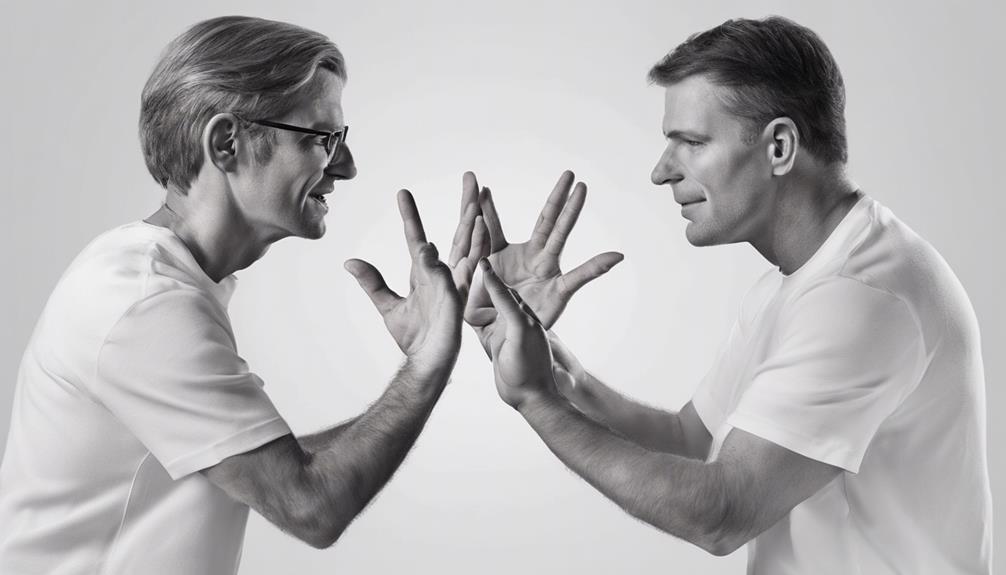In delving into the nuances of executing the ‘I’ gesture in American Sign Language, it becomes clear that even minor changes in the position and motion of the hand can greatly alter the communicated message. Achieving proficiency in this deceptively straightforward sign demands precise attention to detail and a stable hand.
But what if there's more to it than meets the eye? Stay tuned to uncover the nuances of signing 'I' with precision and the key to effective communication in ASL.
Key Takeaways
- Master the 'I' sign by pointing to yourself with index finger for clear communication.
- Focus on hand shape and placement near the chest area for accuracy.
- Ensure precise movement starting at the chest with consistent handshape.
- Avoid common mistakes like using a closed '5' handshape and improper orientation for 'I'.
Understanding the 'I' Sign
Do you know how to accurately sign 'I' in American Sign Language (ASL) by pointing to yourself with your index finger?
Mastering the sign for 'I' is essential for effective communication in ASL. This personal pronoun is commonly used in conversations and requires precision in handshape, movement, and location.
When signing 'I', ensure your index finger points towards yourself, emphasizing the importance of the first person singular. It's crucial to maintain proper facial expressions and body language to enhance the clarity and meaning of the 'I' sign.
By mastering this fundamental sign, you can confidently express yourself and engage in meaningful interactions within the Deaf community. Remember, attention to detail and practice are key to accurately conveying 'I' in ASL.
Let's strive for excellence in our sign language skills to better serve and communicate with others effectively.
Hand Shape and Placement

Transitioning from understanding the 'I' sign in American Sign Language (ASL), mastering the hand shape and placement is crucial for accurate communication. The sign for 'I' involves extending the index finger towards oneself, pointing it towards the chest. This hand shape and placement are key elements to convey 'I' in ASL effectively.
Ensuring that the index finger is positioned near the chest area when signing 'I' is essential. Keeping the hand close to the body while making this sign adds clarity and precision to the gesture. Attention to detail in hand shape and placement is vital for accurately signing 'I' in ASL.
Movement and Orientation

When signing 'I' in American Sign Language (ASL), precision in movement and orientation is crucial for effective communication. To ensure clarity and understanding, here are some key points to consider:
- Direct Movement: Begin the sign 'I' at the chest and move outward in a straight line. This clear and purposeful movement helps convey your message accurately.
- Eye Contact: Maintain eye contact while signing 'I' to establish a connection with your conversation partner. This simple gesture enhances communication and shows respect.
- Neutral Facial Expression: Keeping a neutral facial expression while signing 'I' helps prevent any misinterpretation of your message. A calm expression allows the focus to remain on the sign itself.
- Consistent Handshape: Ensure the handshape used for signing 'I' remains consistent throughout the gesture. This consistency avoids confusion with other similar signs and ensures smooth communication.
Common Mistakes to Avoid

To ensure accurate communication while signing 'I' in American Sign Language (ASL), it's crucial to be mindful of common mistakes that should be avoided. One common mistake to steer clear of is using a closed '5' handshape for 'I', as this can be easily confused with the number '5' in ASL. Additionally, it's vital to ensure that the palm orientation of the 'I' sign is facing inward towards the signer's body to convey the intended meaning accurately.
Another mistake to watch out for is the placement of the 'I' sign in relation to the signer's body. It's essential to be mindful of this positioning to avoid any misinterpretations. Maintaining a straight, upright hand position while signing 'I' is also crucial to prevent any confusion.
Consistent practice is key to mastering the 'I' sign with precision. By practicing regularly and paying attention to these common mistakes, clarity in communication can be greatly improved.
Practice Tips for Mastery
For those striving to master sign language proficiency, honing the 'I' sign through dedicated practice is essential for precision. To master this foundational sign effectively, we recommend the following practice tips:
- Focus on Form: Pay close attention to the handshape, location, and movement required for the 'I' sign to ensure accuracy in your signing.
- Utilize Mirrors: Use mirrors during practice sessions to visually check your signing and make necessary adjustments for precision.
- Seek Feedback: Engage with fluent signers to receive constructive feedback on your technique and learn from their expertise.
- Record for Review: Record yourself signing the 'I' gesture to review and identify areas that may need improvement or refinement.
Frequently Asked Questions
How Do You Sign Precise in Asl?
When signing precisely in ASL, we focus on maintaining clear handshapes, proper placement, and smooth movements.
Attention to detail in facial expressions and body posture is vital for conveying accurate meaning. Keeping eye contact while signing enhances communication.
Consistent hand placement near the chest or shoulder area is crucial. By emphasizing these elements, we ensure the clarity and precision of our signing, making it easier for others to understand our message.
How Do You Make an I in Sign Language?
When signing 'I' in American Sign Language (ASL), we point our index finger towards ourselves. This self-referential gesture is essential for clear communication.
Achieving precision in handshape, movement, and location is crucial. Mastering the 'I' sign is fundamental in ASL conversations. Learning the correct formation enhances our ability to express ourselves effectively.
It's a key concept in ASL, and getting it right is vital for fluent signing.
How Do You Sign Perfectly in Asl?
We sign perfectly in ASL by practicing regularly, focusing on handshape, finger positioning, facial expressions, and body language. Seeking feedback from skilled signers helps us improve.
Our proficiency grows as we pay attention to details and seek guidance. Consistent practice and dedication are key to mastering ASL signing.
Why Is Precision Important in Asl?
Precision in American Sign Language (ASL) is crucial for clear communication. Small variations in signs can alter meanings significantly, leading to misunderstandings. Attention to detail ensures accuracy, preventing confusion in sign language.
Consistent and precise signing enhances comprehension for both signer and audience. Being exact allows effective expression of thoughts and emotions without ambiguity. Mastering precision in signing 'I' and other signs is essential for effective communication in ASL.
Conclusion
In mastering the sign language, precision is key to effective communication. By focusing on deliberate movements and attention to detail, the 'I' sign can be conveyed accurately in American Sign Language.
One interesting statistic to note is that there are over 500,000 people in the United States who rely on ASL as their primary form of communication.
Practice mindfulness, maintain a steady pace, and avoid common mistakes to ensure clarity and mastery in signing 'I'.











